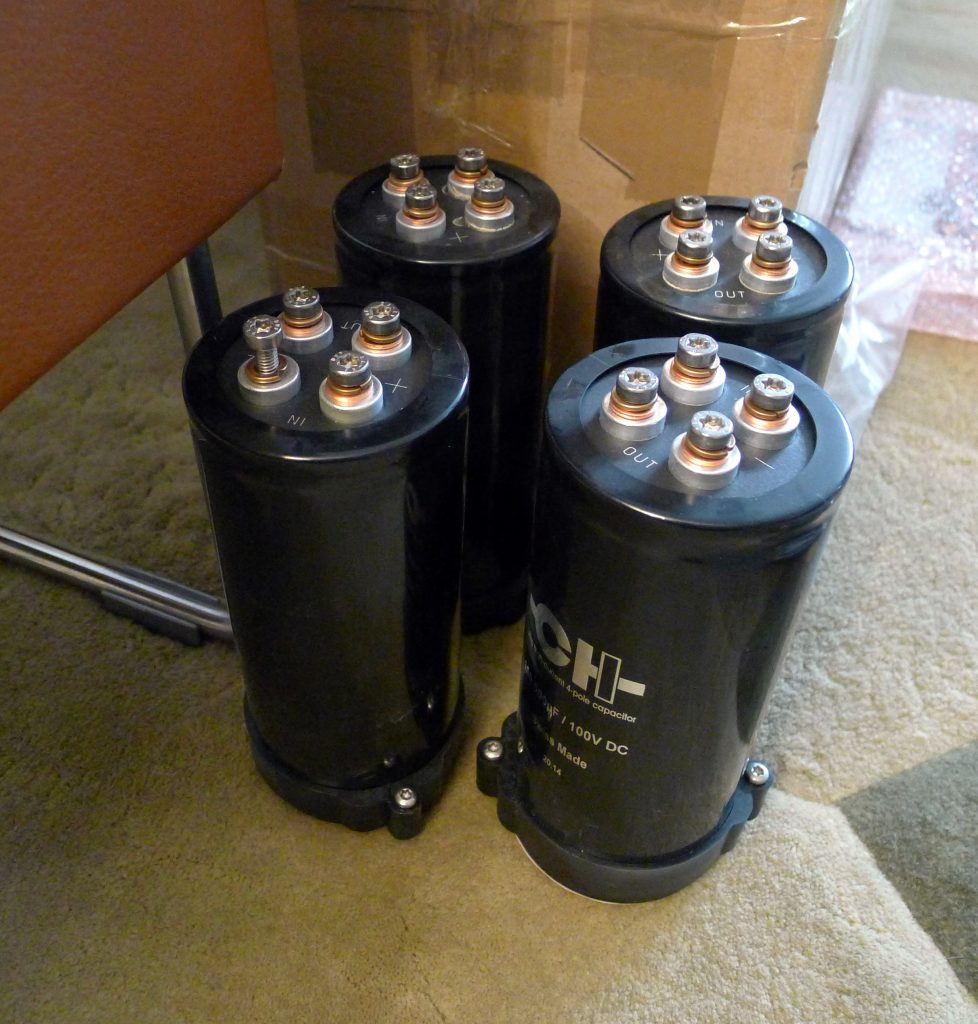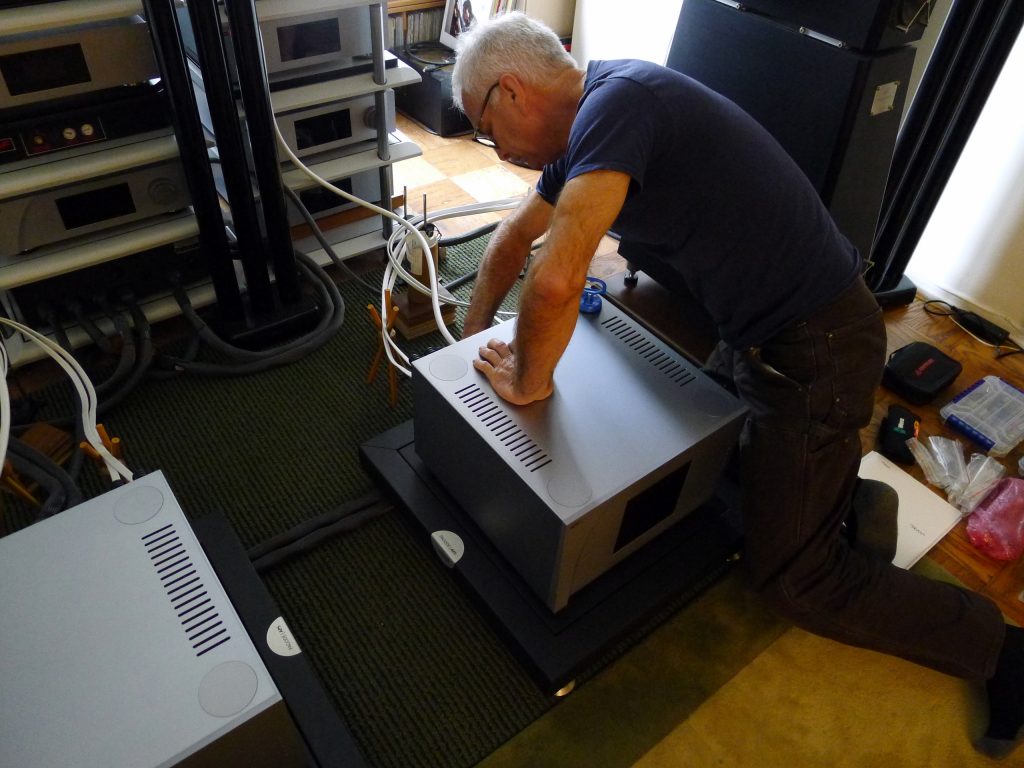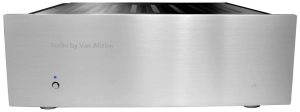The old capacitors.
A Parcel Arrives
One day a box of gargantuan capacitors arrived—really heavy industrial cans measuring nearly 7" high and 3" in diameter. They were destined to replace the main caps in my CH Precision M1 monoblocks. This was the hardware component of the newly released M1.1 Amplifier mod.
I had been informed about the modification in a pre-release email:
The upgrade consists of changing the main power supply capacitors of the M1 to new special ones. These are huge electrolytic capacitors that act as energy reservoirs for the amplifier boards. The sonic improvement that these new capacitors bring is quite surprising. The upgrade is done directly at your home by a certified CH technician…
It sure sounded tempting. Who doesn't want to give their amps more capacitance? Quite out of character, as I am a reluctant early adopter, I didn't think twice and immediately signed on. I felt comfortable making the jump because this manufacturer has a proven track record. Nearly all of the product releases they've sent me have panned out.
My decision was facilitated by how convenient they made it. As detailed in the email, for an all-inclusive price of $3000 per amplifier, they send you the hardware in advance, a tech shows up at an appointed time, and you direct him to your amps. That's it: no shipping hassle, no downtime without music. The work is done in your home. Doesn't get much easier than that!
Except you have to write a fat check—which they've also tried to make go down easy. An M1.1 amp shipping now with the upgrade has an MSRP of $54,000, up from $51,000. The difference in price is exactly what they are charging current owners. There is no markup for current M1 owners.
Introductions
Raphael Pasche, the CH press rep, had provided this introduction for the person doing the installation.
The technician I am contracting is Stirling Trayle. He has his own company, Audio Systems Optimized, and works with end-customers, helping them set up and improve their system… With his expertise at setting up systems, he is able to provide an extra level of services (outside the scope of the upgrade) to our customers.
Stirling Trayle at Work on my M1 monoblock.
Having never heard of this fellow Stirling Trayle, I did some poking around on Audio Systems Optimized. I discovered he was no ordinary tech. Reports of Stirling Trayle's work has appeared in such mags as hi-fi+, TAS, and Stereophile, with the consensus opinion that he is one of the foremost techs on the scene, a veritable setup magician. As explained in Raphael's email, beyond being competent to do the upgrade, Stirling would provide value added.
He arrived punctually on a recent Friday morning. We sat down for a get-acquainted chat and were soon deep into a discussion about how sound pressurizes space. What is it that makes the experience of being in a cathedral feel so very different from being out of doors? How does the human body pick up these cues? Some of the mechanisms are known, i.e. the surface of the eye is very sensitive to high frequencies; lower frequencies are felt bodily, particularly in the chest. Meanwhile, as the talk spun deeper, I was aware of the clock ticking. Why we were dwelling on theory when there was work to do? It occurred to me—maybe he was interviewing us?
Stirling asked to take a benchmark. I played a few CDs from my current rotation, then some of his own. He complimented the timing and low noise floor, then pointed out two areas of concern:
1) The soundstage was not pressurized evenly across the horizontal span. It should be uniform without any gaps or holes in it. I wasn't sure I understood this concept; I certainly didn't hear it.
2) He mentioned a conflict between the tweeters resulting in occasional harshness possibly due to comb filtering or the tweeters being out of alignment. Again, I couldn't say I got what he was honing in on: I didn't hear any harshness on top. We'll come back to these observations in short order, post-upgrade.
What's Changed?
When Stirling lifted the M1 cover and removed one of the old caps, I hoisted it while holding a new one in the other hand. Visually, the new ones are a little bigger—maybe an inch taller and about the same diameter—but they are noticeably heavier.
Replacing the four caps in a pair of M1s took four hours and went without a hitch. When we sat down and listened again, the sound was about what you'd expect after changing a component's main capacitors—dark, dense, and thick. The new caps were beginning a burn-in process that would go on for weeks.
Old (black) & New (red) Capacitors
Part Two: Speaker Optimization
That Sunday afternoon, Stirling unexpectedly emailed that he had some free time and was available to return and work on whatever I wanted (This was 45 hours after the cap upgrade). On arrival, he asked for the top items on my list. That was easy: a balance issue with the right side being weaker; a tendency for high frequencies to drift to the left. He jumped on the latter: "You just gave me a big clue."
He promptly grabbed a fancy digital leveling device from his tool kit and set about measuring the speakers. Their position in the room was not touched, but the laser tool indicated their height was not the same from the listeners' position. Once that was adjusted, he made the speakers plum to the floor, meaning 0.0 degrees azimuth (the sideways tilt of the speaker, inward or outward) and 0.0 degrees rake (forward or backward angle). Now he was ready to address the issues I mentioned. This involved minute adjustments on the order of fractions of a millimeter followed by listening to evaluate the impact, if any. This process went on for about an hour.
Very soon there were impressive results. The soundstage locked-in and was doing that thing where it projects both forward and back from the speaker plane, while spreading out along the sidewalls into the room. My stated concern about right side weakness was addressed, and I picked up on what he had said earlier about sound pressure equalizing across the horizontal span. The high frequency drift to the left was reduced, but not eliminated. Now, on a concerto recording, the pianist's left and right hands were more or less heard in the center. "Could we continue to get this problem wholly resolved?" I pleaded. Stirling demurred, estimating it would take a day on its own to fully correct it.
Focus was such that you heard the individual instruments working within complex scores. The multiple underlying parts that build up into the melody were laid out, each one independently imaged and dynamically active. Coherency and integration were magnifico.
Later that evening Stirling expounded over a beer and burger. "The goal is to get the output of all the drivers to coalesce in time and phase at the listening seat. I begin with measurements, but that only takes you so far. The last stage is always done with listening impressions. You had the speakers positioned very well, only off by fractions."
Then he dropped a big one: "It may surprise you to know after optimization there is not a lot of difference in how system's sound. Whether it's tubes or solid-state, horns or dynamic drivers, they all sound good in similar ways." Yeow! That implies it's not the gear—it's the setup in the room that's key. I preferred not to dwell on the implications.
Summing Up
My YG Anat Signature speakers with their 88dB sensitivity ain't the easiest load. I always felt they were a trifle under-powered with the M1s driving them. I heard what the Anats were capable of on occasions when I had more powerful amps on the floor.
Now, as I am not an engineer, I can only guess at what's going on electrically, but from a subjective point of view, the power shortfall has been addressed head on with the CH Precision M1.1 capacitor upgrade. By providing a deeper pool of available current, the upgrade is responsible for a major expansion of dynamic range. The sound has more impact and power. In addition, it has become completely effortless. The M1.1 amps are so relaxed at signal peaks they make you relax. I wonder if the M1.1 specs would bear me out on this?
What's more, engaging Stirling Trayle to do the job provided added value. His setup and optimization skills commingled with the cap upgrade and imparted unmatched clarity and focus. The soundstage now has a foundation with substantial gravitas, the instruments upon it are realistically disposed, and it all seems so natural, accomplished without resorting to artificial means (i.e. etched images, lean sound, or any sense of rigidity). There is more flesh, smoothness, and sweetness on top. The bottom end is neither loose nor tight, just taut enough. And timbres are rich and satisfying without being overdone. If only I could freeze the sound just as it is now, preserved for posterity!
We began at point x and we ended up at point y. First the parts came in the mail; then the tech came at the appointed time. The CH Precision M1.1 amp upgrade took all of an afternoon, with a minimum of inconvenience. Factory upgrades in the home—that's a real boon in customer service.
CH Precision
Manufacturers Response
When we started the design of our new A1.5 power amplifier, we did extensive research on electrolytic capacitors, trying to find capacitors with better specifications than were available at the time we conceived our previous amplifiers. We collected samples of various capacitors and measured them on the bench and in the A1.5. When we connected what we nowadays call the red caps, the measurements improved significantly in the performance of the main power supply of the amplifier. We could measure that the power supply had become much more resistant to the disturbance of transient demands and much quicker to respond to transients due to the ultra-low ESR/ESL of the red caps. In theory, a power supply should be a DC voltage which isn't affected by what loads it. With the red caps, the A1.5 power supply lines became stiffer and stronger, the DC voltage was leaning further towards the ideal scenario.
With our great results in mind, we decided to order capacitors for the M1 and to commit to the same measurements. The results were unequivocal. The M1 power supply reacted in the same way as on the A1.5.
Then we brought the red cap mounted M1 amplifier to our listening room. Results conformed to the measurements: with 120,000uF, 20% more than the black ones, the amp had more authority while at the same time having more air, being more fluid. We made two decisions: to introduce the red caps in the M1 and call it the M1.1 (to differentiate it from the original M1). And, secondly, to offer an upgrade path to current M1 owners that incurred the least inconvenience. The upgrade is performed by a CH certified technician directly at the M1 owner's home.
Respectfully,
Raphael Pasche,
Electronics Design Engineer
CH Precision Sàrl

















































